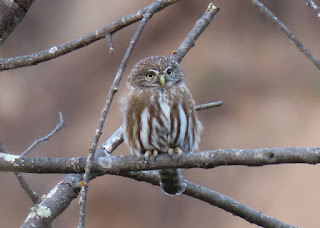I’m leading my first international tours since the start of the pandemic, and everything is going exceedingly well. The first tour just finished a week ago, where we visited the Machu Picchu and the Manu-Kosñipata road, all in the department of Cusco. Some of the lodges and hotels were running with a much-reduced staff, still rebuilding since opening back up to international tourists in July, but you wouldn’t have known it. Clean rooms, excellent meals, and well-maintained trails greeted us at every stop.
We hit the ground running with a full day in the high wetlands near Cusco and superb birding in the Sacred Valley, where a hummingbird feeding station with Giant Hummingbird, Shining Sunbeam, Black-tailed Trainbearer, and Tyrian and Scaled Metaltails was a highlight. We ended the day with this Peruvian Pygmy-Owl, which came in cooperatively for a tour first.
The ruins of Machu Picchu were as fabulous as they promise to be, and while there we had a very close encounter with a pair of the lovely Inca Wren as we climbed through the bamboo to the upper platforms and their magnificent views.
We then birded the forests along the Urubamba River and had wonderful views of this gorgeous Masked Fruiteater.
After birding the dry, rain-shadow side of the mountains north of Cusco, where we saw Mourning Sierra-Finch, White-winged Cinclodes, and Streak-backed Canastero, we dropped down through the moist cloud forests to Wayqecha Biological Station with its enchanting view of hillsides in all directions covered by pristine montane forests. We saw most of the specialties here, including a pair of Urubamba Antpittas at close range in the dark mossy understory. This Yungas Pygmy-Owl and this ridiculously fearless Puna Thistletail just down the road were among many other wonderful birds we saw here.
One of the most exciting sightings of the tour was a mammal in the higher cloud forests at 2000 m elevation. We were in touch with a couple of regular WINGS clients who happened to be on a totally separate tour just a week ahead of us, and they spotted what turns out to be Brown’s Toró clambering into its mossy nest, a caviomorph rodent (that is, related to the guinea pig, capybara, agouti, spiny-rats, and not closely related to rats). What was most amazing is that this species was discovered only in 1999 (described in 2006), and the only evidence of its existence until this week was the lone type specimen in the Lima museum. We hope that some more details of its natural history can be learned from this amazing find.
Among the highlights at our mid-elevation stop were the Andean Cock-of-the-rock lek, Peruvian Piedtail at garden flowers, a pair of Squirrel Cuckoos on the roadside (one carrying a praying mantis back to their nest), a kettle of 87 Swallow-tailed Kites taking off from their night roost and heading south to winter in Bolivia and Brazil, and this male Versicolored Barbet accompanied by a female Silver-beaked Tanager at the lodge’s feeders.
Our last birding lodge was Villa Carmen, where an explosion of tropical diversity greeted us, and the soundscape of so many birds singing was almost overwhelming. We saw over 100 species before lunch each day, with a glowing male Band-tailed Manakin getting the most votes for most memorable bird of the tour. Chestnut-capped Puffbird, Rufous-capped Nunlet, Tawny-bellied Screech-Owl (nesting down in the top of a small, dead palm stem behind cabin 3), multiple Bluish-fronted Jacamars, Blue-throated Piping-Guan (with it’s amazing rattling wing display), Gray-cowled Wood-Rail in the trail almost at arm’s length, and this ear-piercing Red-throated Caracara putting on a show were just a few of the favorite sightings.
Two new hummingbird feeding stations just up the road from Villa Carmen really filled out our birding list, one of them hosting 18 species at the feeder, including this amazing male Rufous-crested Coquette. A bonus there was Buff-tailed Sicklebill that came to its favorite heliconia that was growing off to the side of the garden.
Finally, among the exciting non-bird highlights were the amazing butterflies we saw everywhere. This minute metalmark Syrmatia lamia on our first morning at Villa Carmen was special, as this rarely seen species represents the first sighting in the entire Manu region, the most diverse area in the world for butterflies and also one of the most thoroughly sampled regions anywhere.
I’m now heading onward for our Jungle Lodges of the Madre de Dios tour, where more fabulous birding and natural history experiences await us.















Glad to see you back in the saddle, Rich! I hope your tour continues to go well. Thanks for sharing.
ReplyDelete